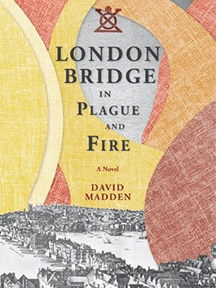By Tea Fani
David Madden is an innovative and stunningly imaginative writer whose passion for writing began early, around age eleven, as he explored the movie theaters, cafés, and shops of Gay Street in his hometown of Knoxville, Tennessee.
“As a movie crazy thirteen year old, my back to the screen, the voices of my screen heroes and heroines so stimulated my imagination that I simultaneously dreamed up stories that I would write in classes at Christenbury Junior High School,” says Madden.
It was the Gay Street Bridge that led Madden to be fascinated by bridges and eventually inspired him to write the astounding novel London Bridge in Plague and Fire. “When I first saw a painting of the ancient London Bridge,” Madden recalls, “what struck me was the sight of over 200 shops and houses, some five stories high, built right upon the bridge. It was as if the shops of Gay Street had been transported and set up on Gay Street Bridge.”
The Phi Beta Kappa graduate of the University of Tennessee was an education major, minoring in history and speech. Before graduation, he served as a mess-man and wiper in the merchant marine and, in 1953, was drafted into the army. Madden went on to receive his Master of Creative Arts at San Francisco State Teachers College. After spending a year studying at Yale Drama School on a John Golden Fellowship, he began a long teaching career. He has written over ten novels and countless poems, essays, plays, and works of literary criticism leading him to be described as a “writer for all genres.”
Madden’s latest novel, London Bridge in Plague and Fire, was published in August 2012 by the University of Tennessee Press. Through the voices of its lively characters, the novel tells the fascinating story of a world icon: the Old London Bridge. After years of reconstruction and evolution, the Old London Bridge became the first stone bridge since the Romans left England. Its architect, the nearly forgotten Father Peter de Colechurch, began working on the Bridge in 1176, partly to honor murdered Archbishop Thomas à Becket.
London Bridge in Plague and Fire takes place in the 17th century, a time full of disaster, superstition, and violence. Daryl Braintree, a young poet living in the famous Nonesuch House on the Bridge, chronicles the life of Father Peter de Colechurch and recites lyrical poems to his witty, yet uninterested, mistress. As both the Great Fire and the Great Plague of London sweep the Bridge, its inhabitants begin to believe that God is punishing the community for its sins. Fearing God’s wrath, they turn to an ancient pagan ritual in which a young virgin must be sacrificed to appease God. Lucien, the villain of the novel and a tragic victim of rape during the English Civil War, is hired to kidnap the girl who is chosen to be sacrificed on the bridge. However, he soon discovers that his victim might be even more evil than he is.
Much like his fictional character Daryl Braintree, Madden uses his imagination to resurrect the Old London Bridge. In the novel, Braintree reveals: “Just before I go to bed, I will enter in this diary my own thoughts, feelings, imaginings about the Bridge. No rules…My nocturnes are events. Are they poetry? Time will tell.”
Similarly, leaving his mind completely open to the whims of imagination, Madden devoted ten to twenty minutes every night before bed to listening to voices from the Bridge and recording the bizarre things they told him.
“I am always looking for ways to affect people,” says Madden. “I want to immerse readers into a whole new world so that they can experience what I am writing.” There is no doubt that he achieves this purpose in London Bridge, where he combines poetic prose with striking historical facts to create a spellbinding experience for his readers.
Madden is currently working on a memoir called “My Intellectual Life in the Army,” and another book, Civil War Worldwide and Throughout History, modeled after Machiavelli’s The Prince. He has also been devoting much of his time and energy to exploring and advocating myriadmindedness, a radical revolution in the way people think.
For more information on David Madden’s work, visit www.davidmadden.net.
Tea Fani is a senior at Kenyon College majoring in political science. Kenyon College is home to the Beta of Ohio chapter of Phi Beta Kappa.




